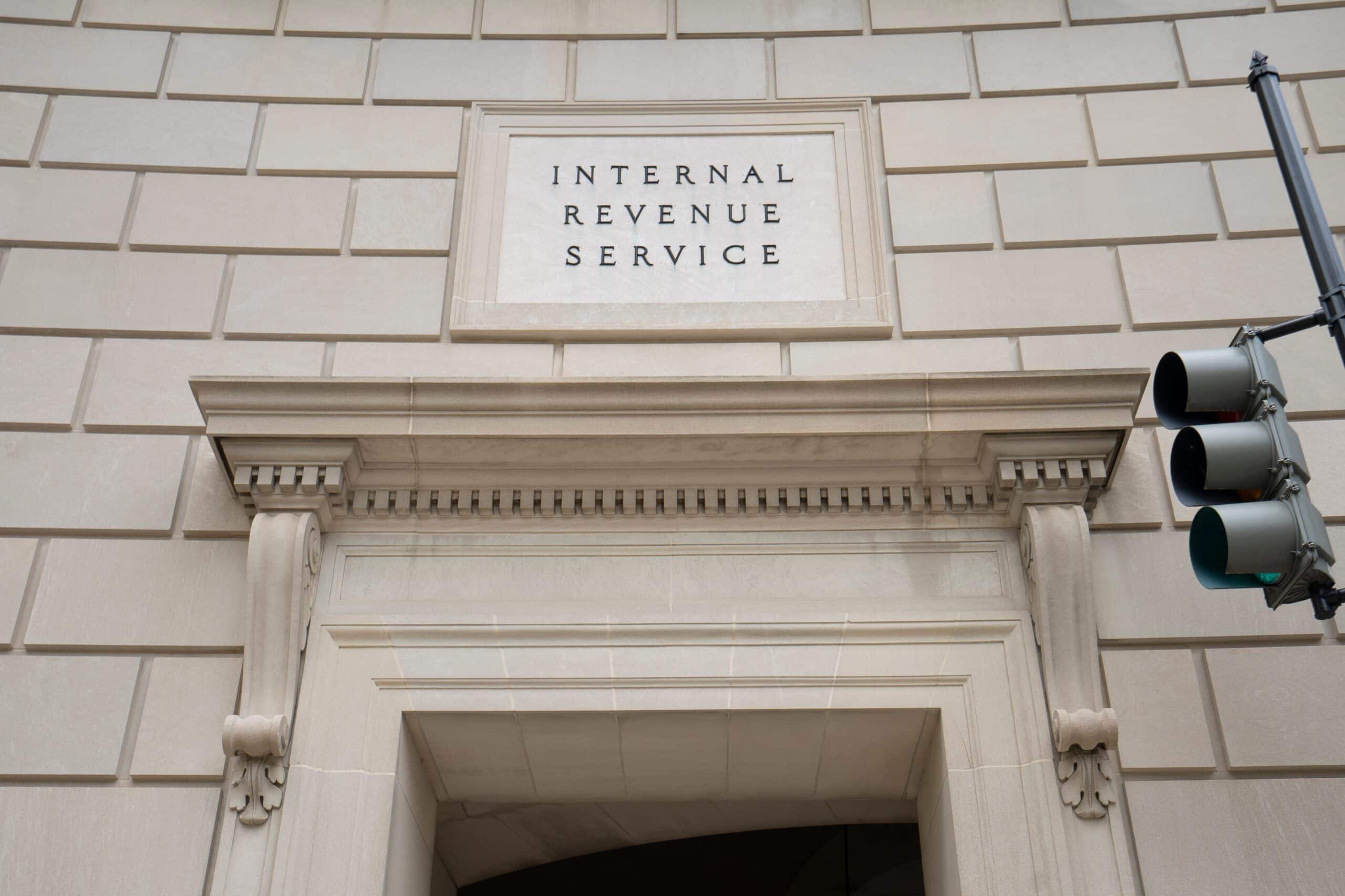Investors can navigate the end-of-year tax maze with expert insights on IRS tracking tactics, offsetting NFT losses and crucial tax considerations for crypto miners and stakers.
The IRS has ratched up its monitoring of digital assets.
Photo from Shutterstock
Posted December 28, 2023 at 3:17 pm EST.
As the year closes, crypto investors face the annual challenge of navigating the complex world of digital asset taxation. With the Internal Revenue Service (IRS) increasing its efforts to monitor and tax cryptocurrency transactions, investors must be well informed to ensure they are compliant.
From understanding how the IRS tracks crypto activities to employing strategies like tax loss harvesting for NFTs, and grasping the tax implications of mining and staking, this guide delves into crucial issues that crypto enthusiasts – seasoned traders and newbies – should know for effective, year-end tax planning.
1. You can’t hide from the IRS
The decentralized, anonymous nature of many digital asset transactions might tempt investors not to report those assets at tax time. However, the IRS has ways of finding out and the penalties are steep if it catches someone intentionally lying on their tax forms.
“Brokers like Coinbase and Gemini are required to report 1099-MISC forms, which report income, like staking income. The IRS receives a copy of those forms, along with the taxpayers,” said CoinLedger CEO David Kemmerer during a call with Unchained, explaining one of the ways that the IRS can learn about crypto holdings.
Beyond the 1099 forms, Kemmerer noted that the IRS employs on-chain analysis firms to track cryptocurrency movements. The IRS has also used John Doe summonses, a legal tool to obtain information from crypto exchanges about unidentified taxpayers who might be attempting to evade paying taxes.
Takeaway: Ensuring complete transparency in your crypto transactions is vital. With the IRS increasingly vigilant and equipped with sophisticated tracking methods, proper reporting is essential to avoid legal complications.
2. Salvage those Rekt NFTs
The crypto winter has been particularly hard on non-fungible tokens (NFTs), with a staggering number of the assets plummeting in value. A dappGambl study from September revealed that out of 73,257 NFT collections reviewed, 69,795 had a market cap of 0 ether (ETH), rendering them essentially worthless. In this challenging landscape, innovative strategies like tax loss harvesting have emerged for investors to offset these losses.
Crypto firm Unsellable buys those devalued or illiquid NFTs, which helps an investor convert paper losses into actual financial losses that can be documented for tax purposes. Those losses can potentially offset other capital gains or reduce taxable income.
“Tax loss harvesting typically involves going through your portfolio and figuring out the losses that you’ve taken this year where you can part with those assets,” explained Unsellable co-founder Skyler Hallgren in a phone interview. “You can realize those losses to write down the capital gains that you had this year. In the United States, you can write down unlimited capital gains, and up to an additional $3,000 in regular income. Any unused losses can be carried forward into future years as well.”
“For illiquid NFTs, the decision gets a little bit easier because, for the most part, those were projects that were rug pulls or have been abandoned since then,” he continued.
Takeaway: The sharp decline in NFT values offers a chance for investors to use tax loss harvesting to potentially offset other gains or reduce taxable income.
3. Record mining, staking values
Mining and staking are two key methods for earning digital assets, but they also bring unique tax implications. Mining involves using computing power to solve complex mathematical problems that validate transactions on the blockchain, rewarding miners with new crypto tokens. Staking, on the other hand, involves holding funds in a crypto wallet to support the operations of a blockchain network, earning rewards in return. Both mining and staking are viewed by the IRS as income-generating activities.
“Any form of generating income with crypto, like mining or staking, is taxed at the fair market value of the cryptocurrency at the time it was received,” Kemmerer explained. “As an example, let’s say I got a job and they paid me in 0.5 bitcoin back in July. I’m booking income at the fair market value of bitcoin in July.”
This means the crypto earned, whether you still own it, is taxable based on its value at the moment you receive it, not when you decide to sell or exchange it. This approach can have varying implications.
For instance, if the crypto’s value rises after you receive it, your tax liability is based on the lower value at the time of receipt, potentially reducing your tax burden. However, if the value decreases later, you still owe taxes based on the initially higher value at the time of acquisition. This can lead to a challenging situation where your tax bill might be higher than the current market value of the crypto.
Takeaway: Diligent financial tracking of the value of mining or staking rewards at the time of receipt is essential for accurate tax reporting, as the IRS taxes these activities based on this initial value, significantly impacting your tax responsibilities.
CORRECTION (Dec. 28, 2023, 13:22 EST): Amends Hallgren quote regarding write-down in the U.S. of unlimited capital gains and up to additional $3,000 in regular income.
- SEO Powered Content & PR Distribution. Get Amplified Today.
- PlatoData.Network Vertical Generative Ai. Empower Yourself. Access Here.
- PlatoAiStream. Web3 Intelligence. Knowledge Amplified. Access Here.
- PlatoESG. Carbon, CleanTech, Energy, Environment, Solar, Waste Management. Access Here.
- PlatoHealth. Biotech and Clinical Trials Intelligence. Access Here.
- Source: https://unchainedcrypto.com/3-crypto-tax-tips-from-irs-tracking-to-nft-losses/
- :has
- :is
- :not
- :where
- $3
- $UP
- 000
- 13
- 152
- 17
- 2023
- 22
- 28
- 31
- 32
- 73
- a
- About
- About Crypto
- accurate
- acquisition
- activities
- actual
- Additional
- After
- along
- also
- an
- analysis
- and
- annual
- Anonymous
- any
- approach
- ARE
- AS
- asset
- Assets
- At
- attempting
- avoid
- back
- based
- BE
- because
- been
- Bill
- Bit
- Bitcoin
- blockchain
- blockchain network
- booking
- both
- bring
- Building
- burden
- but
- Buys
- by
- call
- CAN
- cap
- capital
- carried
- challenge
- challenging
- Chance
- Closes
- Co-founder
- coinbase
- collections
- complete
- complex
- compliant
- complications
- computing
- computing power
- considerations
- continued
- convert
- crucial
- crypto
- crypto enthusiasts
- Crypto Exchanges
- Crypto investors
- crypto miners
- Crypto Taxes
- CRYPTO TOKENS
- crypto transactions
- Crypto wallet
- Crypto Winter
- cryptocurrency
- Current
- David
- December
- decentralized
- decide
- decision
- Decline
- decreases
- digital
- Digital Asset
- Digital Assets
- documented
- DOE
- down
- during
- earned
- Earning
- easier
- Effective
- efforts
- emerged
- employing
- employs
- ensure
- enthusiasts
- equipped
- essential
- essentially
- ETH
- Ether
- Ether (ETH)
- evade
- example
- exchange
- Exchanges
- expert
- Expert Insights
- explained
- explaining
- Face
- fair
- financial
- finding
- firms
- For
- For Investors
- form
- forms
- Forward
- from
- funds
- future
- Gains
- Gemini
- generating
- going
- got
- guide
- had
- hand
- Hard
- Harvesting
- Have
- he
- helps
- Hide
- High
- higher
- holding
- Holdings
- How
- However
- HTTPS
- i
- if
- impacting
- implications
- in
- Income
- Income-generating
- increasing
- increasingly
- information
- informed
- initial
- initially
- innovative
- insights
- instance
- intentionally
- internal
- Internal Revenue Service
- Interview
- into
- investor
- Investors
- involves
- IRS
- issues
- IT
- ITS
- Job
- John
- JOHN DOE
- jpg
- July
- Key
- keys
- Know
- landscape
- later
- lead
- LEARN
- Legal
- liability
- like
- little
- loss
- losses
- lower
- many
- Market
- Market Cap
- market value
- Mastering
- mathematical
- max-width
- me
- means
- methods
- might
- Miners
- Mining
- moment
- Monitor
- monitoring
- most
- movements
- must
- Nature
- Navigate
- navigating
- network
- New
- new crypto
- NFT
- NFT collections
- NFTs
- non-fungible
- non-fungible tokens
- NON-FUNGIBLE TOKENS (NFTS)
- noted
- number
- obtain
- of
- Offers
- offset
- offsetting
- on
- On-Chain
- On-chain analysis
- ONE
- Operations
- or
- Other
- out
- own
- paid
- Paper
- part
- particularly
- paying
- phone
- photo
- planning
- plato
- Plato Data Intelligence
- PlatoData
- pm
- portfolio
- posted
- potentially
- power
- problems
- projects
- proper
- Pulls
- purposes
- quote
- realize
- receive
- received
- receives
- record
- reduce
- reducing
- regarding
- regular
- REKT
- rendering
- report
- Reporting
- required
- responsibilities
- return
- Revealed
- revenue
- reviewed
- rewarding
- Rewards
- Rises
- rug pulls
- s
- Said
- say
- seasoned
- sell
- September
- service
- sharp
- should
- shutterstock
- significantly
- since
- situation
- SOLVE
- Someone
- sophisticated
- staggering
- stakers
- Staking
- Staking Rewards
- States
- Still
- strategies
- Study
- support
- tactics
- taken
- tax
- taxable
- Taxation
- Taxes
- taxpayers
- than
- that
- The
- The Capital
- their
- Them
- then
- These
- they
- this
- this year
- those
- Through
- time
- to
- Tokens
- tool
- track
- Tracking
- tracks
- Traders
- Transactions
- Transparency
- two
- typically
- u.s.
- Unchained
- understanding
- unique
- United
- United States
- unlimited
- unused
- use
- used
- using
- VALIDATE
- value
- value of bitcoin
- Values
- varying
- viewed
- vital
- Wallet
- was
- ways
- WELL
- were
- when
- whether
- which
- WHO
- Winter
- with
- world
- write
- year
- years
- you
- Your
- zephyrnet












